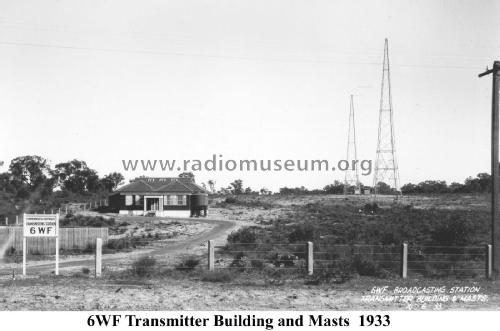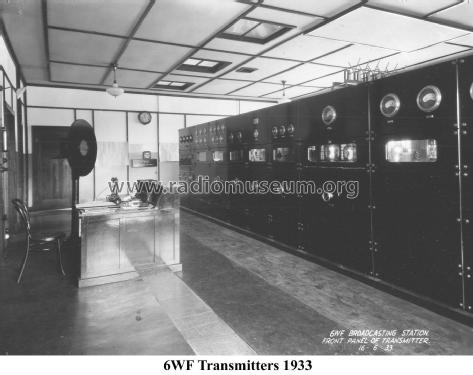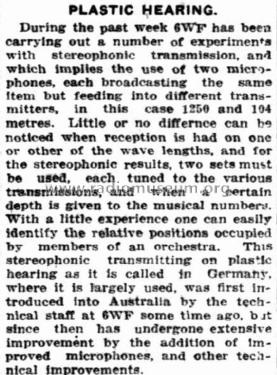6WF Perth, Western Australia
Broadcasting Stations
- Country
- Australia
- Manufacturer / Brand
- Broadcasting Stations
- Year
- 1924
- Category
- Commercial Transmitter (TX not Transceiver)
- Radiomuseum.org ID
- 350209
- Wave bands
- Broadcast only (MW).
- from Radiomuseum.org
- Model: 6WF Perth, Western Australia - Broadcasting Stations
- Notes
-
6WF began its life on Wednesday 4 June 1924 as Western Australia's first, and only Australia's fourth, radio station.
It drew its early name from Westralian Farmers Ltd, which started the operation to provide information and entertainment to rural areas, and the station was based in the company's building.
The station was initially a low-power station, broadcasting at 500 watts at 1250 kHz. However, in 1929, the station's power was increased to 10,000 watts, and its frequency was changed to 720 kHz. This allowed the station to broadcast to a wider audience throughout Western Australia.
In 1932, 6WF was acquired by the Australian Broadcasting Commission (ABC). The ABC continued to operate the station as a commercial radio station until 1942. In 1942, ABC converted 6WF to a public radio station, and it began broadcasting a variety of programs, including news, current affairs, and educational programs.
6WF is still one of the most popular radio stations in Perth today. The station broadcasts a variety of programs, including news, current affairs, educational programs, and music. 6WF is also the flagship station for the ABC Radio Local network in Western Australia.
Here is a timeline of some of 6WF's major milestones:
1924: 6WF was established by Wesfarmers and began broadcasting as a commercial radio station.
1928: 6WF was possibly the first Australian radio station to experiment with stereophonic transmission.[2]1929: 6WF's power is increased to 10,000 watts and its frequency is changed to 720 kHz.
1932: 6WF is acquired by the Australian Broadcasting Commission (ABC).
1933: 6WF transmitter was relocated to Wanneroo (now called Hamersley).
1942: 6WF is converted to a public radio station by the ABC.
1950s-1960s: 6WF broadcasts a variety of programs, including news, current affairs, educational programs, and music.
1970s-1980s: 6WF continues to broadcast a variety of programs, and it becomes the flagship station for the ABC Radio Local network in Western Australia.
1990s-2000s: 6WF continues to be one of the most popular radio stations in Perth, and it broadcasts a variety of programs, including news, current affairs, educational programs, and music.
6WF has played a significant role in the development of the radio industry in Western Australia. The station has been a popular source of news, information, and entertainment for listeners for over 90 years. 6WF is also a valuable community asset, and it plays an important role in informing and educating the public.
[1] The Daily News (WA) Jun 5, 1924, page 5.
[2] Sunday Times (WA) Sep 30, 1928, Page 7.
- Author
- Model page created by Gary Cowans. See "Data change" for further contributors.
- Other Models
-
Here you find 3 models, 3 with images and 0 with schematics for wireless sets etc. In French: TSF for Télégraphie sans fil.
All listed radios etc. from Broadcasting Stations
Forum contributions about this model: Broadcasting: 6WF Perth, Western Australia
Threads: 2 | Posts: 2
6WF was officially opened on June 4, 1924, by the Labor Premier of WA, Mr. Philip Collier.
From the The Daily News (Perth, WA ) 5 Jun 1924, page 5.
6.W.F.
COMMENCES BROADCASTING.
PREMIER OPENS WIRELESS STATION.
"KEEP THE BOYS ON THE FARM."
"Stand-by to receive broadcast concert from '6 W.F.' on 1,250 metres wavelength."
This is the warning which, commencing from last night, will daily go out at 7 p.m. to "listeners-in" throughout the State. Last night the large broadcasting station installed by the Westralian Farmers, Ltd., at their building in Murray Street was officially opened by the Premier (Mr. P. Collier) and was followed by a musical program that radiated in all directions at the speed of 186,000 miles per second. From Broome to Eucla figures crouched over tables in spare rooms, turning little vulcanite knobs and listened to what the Premier had to say.
No wonder the Premier was nervous when speaking to his invisible audience last night.
"I would want to be well paid if that was the way I had to earn my living. It is the most nerve-racking thing to be imagined, to have to make a speech to an empty room," the Premier said as he mopped his brow after the address was broadcast.
It was no good the Premier using gesticulation to assist his voice, for no one could see him as he sat in the studio a couple of feet distant from the microphone. The utmost silence had to be observed in the studio, so that sounds other than speeches and music would not be broadcast.
Even the Premier, who spoke from a few notes, was not at liberty to turn over the pages, for the slight sound made would have been magnified into a sound like distant thunder. Consequently, he had to let sheet after sheet float gracefully to the floor at his feet as it had served its purpose.
Many people were under the impression that the plant seen last night was the finished apparatus. It was learned, however, that definite results over 200 miles were not expected last night. At present the station is only a half-kilowatt transmitter unit. This is intended to act as the "drive" for the 5-6 kilowatt set which is to be installed in a few weeks, and which Mr. Murray said would have a capacity two and a half times that of Applecross. During the progress of the concert, a telephone message was received from York stating that the items and speech were being received. Other country centres have also reported similar good results.
In order to mark the epoch in West Australian history with the inauguration of broadcast wireless, the directors of the Westralian Farmers Ltd. invited a large number of guests to the ceremony, and when the time had arrived for the commencement of the programme, the social room was accommodating about 800 people, while many others were to be found inspecting the apparatus to be found on three floors.
OPPOSITION TO MONOPOLY.
Mr. Basil L. Murray, managing director of the Westralian Farmers, Ltd., addressed the audience from the platform explaining the apparatus and inviting those who had not been able to see the plant to make later appointments. He said the wireless masts which stood 110 feet above the roof of the building weighed something like 3½ tons each and had been manufactured locally, while the whole construction as far as had been possible was of local manufacture. He wished to stress the point that instead of opening an establishment that night, they were really only laying the foundation stone. The plant when completed would be the biggest in Australia. They were contracting to deliver broadcast matter as far distant as Wyndham, where sets had already been sold. The sets they had made had "picked up" South Africa, while they had also "listened-in" to Farmers Ltd., Sydney.
Mr. Murray then welcomed the Premier in the studio, his remarks being broadcast. Downstairs in the social room, a loudspeaker picked up the messages and delivered them in clear, resonant tones which could be heard distinctly throughout the large and crowded hall.
After expressing pleasure at having the Premier with them, Mr. Murray said that the venture was more or less a private one, although they felt that broadcasting in a country as vast as West Australia was a matter of more than private interest. Indeed, it was a matter of national importance. He had learned that day for the first time that the Premier was born on the land, and had lived a good many years there engaged in farming pursuits. He therefore took it that the Premier recognised that one of the big disadvantages of living on the land was its isolation. The young Australian felt that isolation keenly, and in some of the cases, the city lured him away from the land. Australia required its men on the land, and he had great hopes that the inauguration of an efficient broadcasting plant would do more than anything else to keep the young people on the land. He could assure the Premier that they would do everything in their power to establish an efficient broadcasting plant for the State.
He felt he might require some assistance from the Premier in one matter which was disturbing their minds, and which he thought should be made public. An attempt was being made in Melbourne to force their broadcasting venture into a central company, having its headquarters in the Eastern States and giving it the advantages of a huge monopoly. They strenuously objected to being tied up to any Eastern States concern, and looked forward to getting the Premier's support in their hard fight against consolidation.
THE PREMIER'S ADDRESS.
The Premier said: "I am greatly privileged this evening in being asked to open the first broadcasting system of wireless telephony and telegraphy in Western Australia. This has been installed by the Westralian Farmers, Ltd., at a cost of approximately £12,000, and at the present moment has a broadcasting capacity of 600 miles.
The company deserves great credit for its enterprise, for not only will they cater to their own 6,000 clients, but also for the edification and entertainment of numerous other holders of receiving sets throughout the State. An installation of this nature must serve to overcome the isolation which is one of the disabilities of present-day life in the country. It will annihilate distances and bring the people of the outback in touch with everyday life and enjoyment of the city and of other countries. A station of this kind has very special significance to our own State, because of our great distances and comparatively few people, for in no other States do the conditions apply to the same extent. An innovation of this description will be of immeasurably greater benefit to the people of the remotest areas of our own State than to city dwellers. From Esperance and Eucla, in the south, to Wyndham, in the far north, owners of small receiving sets will be able to listen in and enjoy all that can be offered by the great cities in music, singing, or lectures, or any other form of entertainment. This is a wonderful science and has made enormous progress during the past decade. A cable message in tonight's newspaper informs us of a successful experiment in wireless telephony between Great Britain and Australia. Truly it may be said that this day marks an epoch in the history of Western Australia and of worldwide communication through the empyrean blue. It is very gratifying to know that this station has been designed and manufactured in Australia, and being the most powerful on our continent reflects great credit upon those responsible for the undertaking and those who have arranged the installation. In conclusion, I would like to mention one feature that strongly appeals to me, and that is this, that while you are compelled to listen to me, you cannot talk back or interject, for if you should do so I would be blissfully unconscious.
Notwithstanding this, I do not propose to intervene any longer between you and the excellent programme which I understand is to follow, and I therefore have very great pleasure in declaring open this broadcasting station of the Westralian Farmers, Ltd."
The plant was operated last night by Mr. S. Trim, of Amalgamated Wireless of Australasia, Ltd. (Sydney), and Mr. W. E. Coxon, technical adviser to the Westralian Farmer's Ltd.
MUSICAL PROGRAMME.
During the evening songs, violin soli, quartet items, and humorous songs were contributed by Mr. G. C. Haywood, Miss Lilian Pether, the Windowie Quartet,
Mr. Herbert Gibson, and Mr. Rhys Francis.
THE PLANT.
In giving a brief description of the plant, it might be advisable to start from the studio, where the music is created, and follow it through to the aerials, from where it is discharged into the ether. The Westralian Farmers have provided two studios. One is for concerts, brass band music, etc., while the other, a smaller one, is for the dissemination of news, bedtime stories, and market reports. The room is made entirely soundproof and is draped in brown and blue in order to prevent the possibility of echoes. The room is lined with sheet iron to prevent interference from outside electrical induction. On a pedestal stands a microphone of the push-pull, two-button type. This receives the sounds, magnifies them, and passes them through to a three-valve amplifier panel, which converts the sound vibrations into electrical vibrations. A window between this piece of apparatus and the artist enables the operator to direct the singer and speaker if required to approach or recede from the microphone. The electrical vibrations are then passed to another apparatus known as the modulator panel, which contains four 250 T-Valves and also two more amplifying valves. The modulator panel is connected to an oscillator panel of two 250 T-valves. On the top of the modulator and oscillator panels are mounted tuning inductances for the closed and open circuits. From the open circuit inductance, the "lead" goes to the aerial and the other through the hot wire ammeter to the counterpoise system, which stands three feet above the roof for the purpose of creating an artificial "earth."
The aerial of the four-wire cage type is 173 feet long and is suspended between the poles, 195 feet from the pavement. The three panels are enclosed in latticed steel cabinets and look very much like miniature passenger lifts.
TO-NIGHT'S PROGRAMME.
The programme to be broadcast tonight is as follows:—
7 p.m.: Tune in to gramophone (Sonora).
7.5: Bed-time stories.
7.45: Market reports.
7.55: Weather reports.
8.0: Time signal.
8.2: News (cable).
8.15: Mr. Frank L. Robertson, baritone: "Morning," "How's My Boy."
8.30: Miss C. Pether in flute solos: "Papillon," "Allegretto."
8.45: Miss Ida Geddes, contralto: "Deep in the Heart of a Rose," "My Ships."
8.55: Mr. Ned Taylor will discourse.
9.7: Mr. Hugh Torrance, tenor: "Angels Guard Thee," "A Memory."
9.17: Mr. Frank L. Robertson in songs: "Beauty's Eyes," "A Sergeant of the Line."
9.27: Mr. C. Pether, flutist: "Serenade," "Andalouse."
9.37: Miss Ida Geddes will sing: "God's Lullaby," "Abide With Me."
9.45: Mr. Ned Taylor in humorous items.
9.55: Mr. Hugh Torrance will sing: "Old Mary," "I Hear You Calling Me."
10.2: Close down.
A DISAPPOINTMENT.
The failure of the Prince of Wales Theatre to broadcast the Westralian Farmers' concert last night was due, it is understood, to the fact that the firm which installed the plant had inadvertently omitted to secure a licence to receive broadcast from the Commonwealth authorities, who at the last moment prevented the concert taking place.
Gary Cowans, 08.Nov.23
Stereo Broadcast in 1928
In September 1928, 6WF carried out a number of experiments with stereo transmission. They used two microphones, each broadcasting the same item but feeding into different transmitters: 6WF on 1250 meters (238.1 kHz) and the short-wave transmitter on 104 meters (2.88 MHz). Two sets were used and tuned to each station. This was possibly the first stereo broadcast in Australia.
Sunday Times (WA) Sep 30 1928 Page 7.
Gary Cowans, 08.Nov.23


